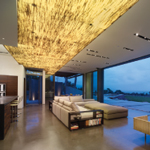At a Glance
Company headquarters
North Bergen, NJ
Founded
1997
Average project duration
6 months
Current US locations
More than 100
When president and chief creative officer of Juicy Couture LeAnn Nealz joined in late 2010, her résumé was already replete with key examples of creative-development victories at a number of well-known brands, including a significant reinvention of Banana Republic. So, it’s no surprise that she called for a revolution in the look and layout of the Los Angeles-inspired clothier’s stores almost immediately. Significant implementation of the new design fell to Brad Lenz, vice president of global architecture and construction for Fifth & Pacific Companies, Inc., Juicy Couture’s parent company, and ultimately his job proved to be no small task, particularly as he worked to help source materials for the refreshed concept while opening a string of new stores across the globe.
For Lenz and his team, the primary goal was to play up Juicy Couture’s upscale, boutique atmosphere and include more signature elements. “Up until two years ago, we had an irreverent dragon’s breath gray palette with taxidermy props,” Lenz says. “Now, we’ve evolved the look to a white-opulence palette of bespoke moldings with Southern California artwork.” Lenz has since overseen the remodeling of approximately 34 US stores and several international locations. The resulting aesthetic evokes a sense of California class that has helped draw first-time and return customers alike.
Sourcing for the new look hasn’t been simple, largely due to Juicy Couture’s international reach. According to Lenz, while most items are custom designed in-house by the brand’s creative and visual teams, some materials are subsequently manufactured all over the world so that Juicy Couture can deliver consistent quality at an appropriate cost and in a timely manner for its stores in each geographic region.
To get the job done, Lenz depends on the services of reliable and creative suppliers such as Pacific Northern and Sequoia Group. “Sequoia is one of our fixture manufacturers that makes very special products; Juicy uses them for bespoke projects,” he says. “Pacific Northern does our volume rollouts, such as when we have a fixture and need 20 of them.”
Current store features include brass, glass, and mirror fixtures and fittings by manufacturers in the United States, China, Great Britain, Greece, Mexico, and the United Arab Emirates. Mannequins come from Adel Rootstein Inc. and Expor Brazil while signage is provided by North American Signs. The stores’ surfboards are custom-made in Southern California, and a variety of suppliers contribute additional visual props, including custom moldings manufactured by Pearlworks Inc., wall coverings designed in-house and printed by Astek Inc., and rugs designed in-house and woven by Tai Ping.
In addition to helping refresh the look of Juicy Couture’s stores, Lenz has played a key role in the brand’s expansion, overseeing the opening of a number of new stores at home and abroad over the past few years. “We’ve built stores in North America, South America, Western and Eastern Europe, Russia [including one in Red Square], the Middle East, and Asia,” he says.
Coordinating numerous construction projects in multiple locations requires a precise, tiered system of corporate approvals that Juicy Couture has perfected over time. “Architectural documents for every Juicy Couture store in the world are drawn by the architectural department in North Bergen, New Jersey, where the team is headquartered, and the construction department specifies and sources all of the materials,” Lenz says. “Our Juicy Couture architectural and construction policies and processes assure the consistent, high-quality, and on-brand completion of each and every store.”

Because of these measures, the brand’s retail aesthetic remains uniform even though it now maintains stores in culturally disparate regions and countries. However, there are still differences resulting purely from the various building requirements of individual locations. One thing that does change often, Lenz says, is the amount of room he has to work with. “Typical store size in the US is 3,000 square feet,” he explains. “Whereas in Asia [where space is at more of a premium] the retail spaces are about half that.”
Additionally, Lenz notes that select locations do have special design elements. Juicy Couture’s Westfield store, which opened in July of 2012 in London’s White City district, features built-in joinery that was manufactured in Hitchin, England, at P&J Storefitters. The artisanal woodwork has compartments for TV screens that feature “videos and images from current Juicy Couture advertising campaigns,” Lenz says, adding that, “Our signature neon, white-opulence paint, pink-edge-lit sign—plus brass, glass, and mirror—provide the proper background to make seasonal product pop.”
By contrast, the brand’s location in Mall of America served as a prototype for a new solid-brass outrigger system. “[It] complements our signature bespoke moldings and boasts a quick, low-cost installation,” Lenz says. “It has flexibility for shelving, side-hang, and face-outs.” The innovative display system proved to be so successful that Lenz’s team brought it to Juicy Couture’s flagship store on Fifth Avenue in New York City for a “re-couture”—just in time for Thanksgiving of 2012.
“The goal is to keep pushing the envelope,” Lenz says. And indeed, even with big goals on the docket for 2013, there’s no doubt that Juicy Couture will continue to persevere as it focuses on a combination of traditional and groundbreaking retail-construction strategies. ABQ
______________________________

Meet Brad Lenz
Where did you go to school?
I graduated from Bucknell University in Lewisburg, Pennsylvania, with a BSBA in accounting and a minor in art history. I really wanted to be an art history major, but I found over time that I was really good at accounting. In the end, it was nice the way both studies worked together for the global corporate responsibilities I’ve had through the years. When I started doing a lot of traveling in Europe and Asia to open stores for the different companies and brands I have worked for, it all came together.
What was your first construction job?
I didn’t follow a classic construction or architecture path; I came in sideways. After nearly 10 years at JCPenney managing accounting, MIS, and corporate marketing departments, I worked at Karen Austin Petites, where I found I had an aptitude for store design and construction—[and for] developing relationships with suppliers for fixtures, furniture, lighting, etc. Karen Austin constructed stores with venture capital money, so it was a tight organization with on-target budgets.
How did you wind up working for Juicy Couture?
About half of the Karen Austin stores were stocked with Liz Claiborne product, so I got to know the Liz people very well. When they offered me a position to join the company and help them build new stores, I jumped at the chance. It was a terrific time and the heyday for Liz Claiborne, which would go on to acquire many companies—such as Juicy Couture. I originally went in as the accountant, and I ended up doing operations, construction, and real estate. I started working with the architects and ultimately acquired responsibility for store design, architecture, and construction.
What do you love about what you do?
It’s been very exciting and challenging to oversee the global expansion of Juicy Couture. I’ve gone through a lot of passport pages. I saw the world and built a lot of retail stores for Juicy and about 19 other brands I’ve worked for—everything from department store rollouts to international launches. It’s been incredible to work with all the different brands and designers, such as Dana Buchman, and working with Isaac Mizrahi on developing his Liz Claiborne shop-in-shop concept.
What personal goals do you have looking ahead?
The most important thing for me is to set people up to succeed, whether it’s the people I work with on staff, our vendors, suppliers, or customers. I want to give people the tools they need to be successful at what they’re doing, [to] achieve their goals, and to lift them up and make their businesses better. That’s the best thing and most important to me.


